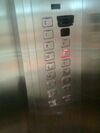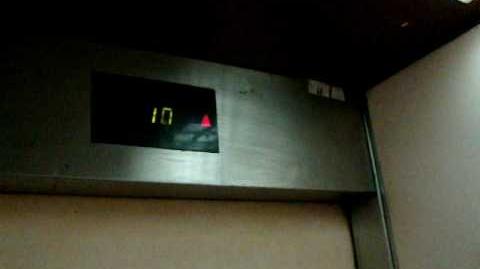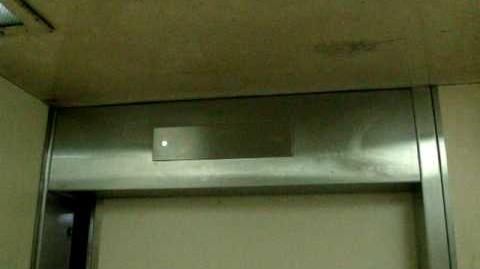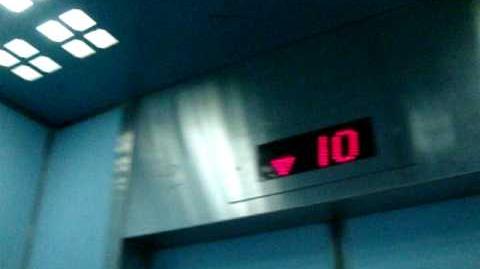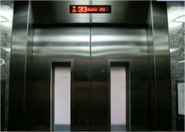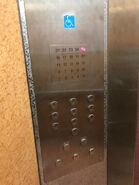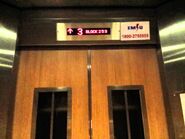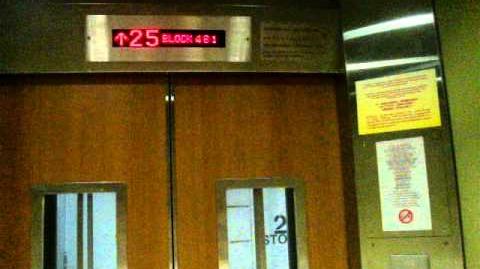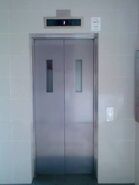This article refers to the elevators that are installed in public housing managed by the Housing and Development Board (HDB) in Singapore.
Overview[]
To be added.
Telemonitoring System (TMS)[]
The Telemonitoring System (TMS) is a system which monitors elevators in high-rise public housing, which was started out the HDB in 1984. As of August 2007, there are more than 17,500 elevators monitored by the system. TMS uses SCADA-based technology to monitor the status of the elevators in real-time from a centralized master station for events such as breakdown and trapped passengers. The elevator maintenance companies are automatically notified of any problem and in most cases, repairs are carried out even before a complaint is received. The introduction of TMS has resulted in better elevator performance as historical data allowed the Town Councils, who are maintaining the HDB estates, to pinpoint problem areas and improve the method of maintenance. Besides detecting problems with the elevators, TMS can also be used to carry out remote testing of elevators and other emergency standby equipment.
Timeline of elevator specifications[]
1950s (Singapore Improvement Trust era)[]
| "Some elevator parts here seems missing!" This list/page is incomplete. You can help the Elevatorpedia by expanding it. |
The Singapore Improvement Trust (SIT), HDB's predecessor, built very few high-rise blocks as compared to the HDB; mostly in Old Airport Road, Dakota Crescent, and Stirling Road (Queenstown). These flats were on average seven floors high, and equipped with one elevator installed in the centre core of the building. Elevators in SIT flats were usually made by Schindler (installed by Harrisons Lister Engineering Ltd.) or (Waygood) Otis . The first elevators to be installed in SIT flats were from Upper Pickering Street built in 1952 and demolished in 2003.
Schindler elevators from this era are distinguished by :
- Wooden cab
- Prominent circular fan on the ceiling, surrounded by two fluorescent lamps
- Single sliding door
- No door close button
- Button indicators written beside the black buttons (as opposed to being engraved on the buttons itself)
- Usually installed in the block's centre core, usually serving levels 1, 3, and 6.
- All fixtures supplied by Schindler themselves.
The characteristics of Otis elevators from that time is unknown, as no known examples could be found as of the late 2000s onwards. However, according to interviews from residents living in SIT flats, Otis was contracted before to supply lifts. Some said they were known to have manual doors, and they were likely involved in installing lifts for SIT flats first before Schindler.
A rare example of some 1950s Schindler lifts is shown below:
Note that the majority of such SIT blocks were demolished throughout the 1990s, so the information above cannot be confirmed.
1960s[]
Elevators in HDB blocks built in the 1960s were mostly made by Hitachi (installed by Marubeni Corporation[1], Schindler (installed by Harrisons Lister Engineering Ltd.) and Express Lift (only from about 1967 onwards). Express Lift (first generation) elevator was found in Toa Payoh, the oldest estate in Singapore, and another one was also found in Block 119 Taman Jurong but it has since been replaced by a Fujitec. Very little is known about elevators from this era, as most 1960s HDB blocks, however, have since been upgraded alongside their elevators or demolished.
Elevators from this era are mostly distinguished by:
- A simpler, more monotonous design, utilising one colour (either dark yellow, green, white or blue). Express Lifts all have metallic cabs. Refurbished ones in the 1990s were mostly given a blue colour.
- Use single doors.
- Simple metallic floor indicators above the door, with small red lights indicating the floor the elevator is traveling through.
- A capacity of 8 persons/545 kg, though exceptions may exist.
- Circular, less decorative fan on top, still surrounded by 2 fluorescent lamps, although this time round unlike 1950s lifts they do not stick out and are protected by a further layer of glass, so that lighting fixtures are not easily stolen.
- Often installed in the middle of a flight of stairs, in-between two floors. Usually serve from 1, 5, 8, 11, etc.
The last 1960s Hitachi elevator to be found in any HDB flats, not refurbished under MUP/ IUP, found in Block 79 Commonwealth Drive completed in 1963/4, was shut down in late 2014 shortly before the last resident moved out for redevelopment. While it has been refurbished in the 1990s, it is the only 1960s Hitachi elevator in any HDB flat to have survive over half a decade of service, as the surrounding blocks in the vicinity were all completely vacated by early 2014. The last surviving original 1960s Express Lift and Schindler installation was gone by around the mid 2000s.
There was also a 1960s Express Lift elevator in this era. An example was found in Block 79 Toa Payoh Central HDB before it was demolished[2] [3] [4].
1970s[]
Most elevators during in the early 1970s to early 1980s were installed by the Fuji Engineering Company (now Fujitec in Singapore after 1976), Fujitec, Fiam (only known installations for a block at Holland Village and another in Taman Jurong), Hitachi (mostly JTC flats),Marryat & Scott, Otis (only known installations for a few blocks at Pipit road and Boon Lay), Express Lift (only until 1973), and Schindler. They have similar basic characteristics of the 1960s elevators.
During that era, besides the HDB, Jurong Town Corporation (JTC) also built flats in Taman Jurong, Boon Lay, Sembawang, Teban Gardens and Pandan Gardens. JTC is known to have at least contracted Hitachi, Fiam, Otis, Marryat & Scott and Toshiba for the installation of elevators for its flats. As JTC's flats were handed over to HDB's management in 1982 just like the SIT flats, they could also be selected for upgrading programmes.
Fuji (later Fujitec)[]
Fujitec began installing elevators in HDB in 1972 as Fuji Engineering Corp. (known as Singapore Fuji Elevator or SFE)[5] before it changed name to Fujitec in 1977. Starting from 1974, Fujitec became the sole manufacturer contracted by HDB for installing elevators, a monopoly that would last until 1990.
Unique characteristics of Fuji/ Fujitec elevators from this era (c. 1973 - 1981):
- Always have a single sliding door
- Originally yellow in colour (many were refurbished with a blue interior during the 1990s)
- Has the old Fujitec "bell" logo on top of capacity ratings, all which are engraved with metal on the button panel.
- Typical 1970s Fujitec round button fixtures and circular metal indicator, with floor numbers inside the plastic circle.
- Older Fujitec Installations from 1973 - 1976 used "candlelight" style indicators with floor numbers cut into the metallic indicator with its exact shape on the exterior, with interior ones having floor numbers inside the plastic circle itself. The interior indicators despite having floor numbers engraved within the plastic circle, have their directional arrows engraved on the panel.
- Installations from 1973 - 1977 had the manufacturer's decal engraved in the cab as "FUJI" above the bell logo before being renamed Fujitec in 1976. It took some time for the production of new parts branded as "Fujitec" to begin and be transported and assembled at site, therefore the first installations with the "Fujitec" decal were only seen in 1977.
- Installations from 1978/9 - 1981 had the exterior indicator located on the door frames itself.
The last set of Fuji(tec) Elevators in HDB flats left found at Blk. 55 Sims Drive, and it was shut down by 31 March 2018 SGT as the block was slated for demolition. It would also be worthwhile noting that Blk 52 Chin Swee Road (completed in 1974) still has a Fuji(tec) elevator designated for refuse use in the commercial area of the block, but it has long been shut down and is defunct. It is unlikely it would be turned on for use in the future, but even so it would likely be modernised first or even replaced. While there are several other Fujitec Elevators in the 1970s found in HDB Flats left, the remaining ones are being shut down at a very fast rate and may be extinct very soon. Here are some of the locations where there are still such lifts left:
- Blk. 46 - 50 Bedok South Avenue 3 HDB (Shut down in May 2018 for demolition under SERS, interim rental lease expired on 30 April 2018)
- Blk. 321 - 323 Clementi Avenue 3 HDB (To be shut down by 4Q2018 under SERS, blocks will be demolished. Blk 322 was closed in September)
- Blk. 712 Ang Mo Kio Avenue 6 commercial HDB (Lift refurbished with a blue interior in the 1990s)(CONFIRMED TO BE REPLACED BY 2025)
Toshiba[]
Toshiba elevators were supplied and installed by Chevalier since the early 1970s. They were mostly found in JTC blocks in Pandan Gardens and Teban Gardens built in 1976 - 1979. They may have been contracted again to come back and refurbish a few of their installations in Pandan Gardens in the 1990s under the Interim Upgrading Programme (IUP).
Unique characteristics of Toshiba elevators:
- Has a digital segments floor indicators (if IUP refurbished).They have conventional floor counter with orange illuminating numbers if not refurbished.
- Center-opening and double sliding doors
- Fan is hidden by square cover
- Operating instructions listed in Chinese.
- Rectangular-shaped buttons, yellow illuminations. Exterior buttons are circular and made out of plastic
- Usually have white cab colour if original and orange cab colour if IUP refurbished.
The last set of any type of Toshiba Elevators found in HDB blocks at Blk. 410 - 412 Pandan Gardens, all refurbished under IUP once as well, was shut down in March 2017 for replacement.
Marryat & Scott[]
Marryat & Scott elevators in HDB were assembled and installed by a local firm, General Engineering and Trading[6], and the brand name is not shown on the elevator's button panel. They were commonly found in Holland Village and Jalan Besar.
Unique characteristics of Marryat & Scott elevators:
- Floor Indicator integrates numbers and illuminations together (orange in colour)
- Brand is not given as equipment was assembled by General Engineering and Trading.
- External lift button reads "LIFT COMING"
- Buttons used were the 1970s Dewhurst US81 series
- Usually comes in white or dark green cab colour. Many were refurbished with blue cab during in the 1990s.
- Some elevators were refurbished in the 1990s by Thames Valley Controls (possibly on behalf of EM services) and were given white or dark green cab colour. An example of this was found in Blk. 13 Holland Village and Blk. 168A Queensway.
The last Marryat & Scott Elevators not refurbished under MUP/ IUP, found in Block 31 - 32 Holland Close, were shut down in 2012 under LUP. The last Marryat & Scott Elevators refurbished by Thames Valley Controls under MUP, found in Block 11 - 13 Holland Drive, were shut down in 3Q 2014 for replacement.
Hitachi[]
Prior to 1972, Hitachi elevators in flats built by HDB and JTC were supplied and installed by Marubeni Corporation.
Unique characteristics of Hitachi elevators:
- The doors come in single sliding two-speed doors and in some cases centre opening doors [for Taman Jurong JTC flats.
- Square metallic buttons with metallic border after refurbishment. Original cab has plastic buttons.
- Mostly have digital floor indicators (presumably after 1990s refurbishment, original indicator characteristics not known)
- Cab colour comes in white, those which have been refurbished in the 1990s were given blue colour.
The last of such lifts, found in Block 63-66 Yung Kuang Road, were shut down by 1Q2012 and subsequently replaced into ULifts.
Otis[]
Otis also supplied and installed a number of elevators in flats built by HDB and JTC. They were commonly found in Boon Lay, Taman Jurong, and Teban Gardens.
Unique characteristics of Otis elevators:
- A simpler, more monotonous design, utilising one colour (either dark yellow, green or blue). Refurbished ones in the 1990s were given a blue colour.
- Using either single or double doors.
- Simple metallic floor indicators above the door, with small red lights indicating the floor the elevator is travelling through.
- Black Lexan buttons supplied by Otis themselves
- A capacity of 8 persons/545 kg, though exceptions may exist.
- Circular, less decorative fan on top, still surrounded by 2 fluorescent lamps, although this time round they do not stick out and are protected by a further layer of glass.
- Often installed in the middle of a flight of stairs, in-between two floors.
Express Lift[]
From the early 1970s until 1973, Express Lift installed elevators in HDB flats using their 2nd generation features.
- Metallic cab
- Fixtures 2nd Generation metallic Express vandal resistant buttons
- 7 segment indicator with asterisks inside, creating a "starburst" pattern
- Single sliding door
- Circular, less decorative fan on top, still surrounded by 2 fluorescent lamps which are protected by a layer of glass.
The last 2nd Generation Express Lift to be found in HDB flats were found at Upper Boon Keng Road. They were shut down (as an estate even though some blocks closed earlier) between 29 November 2006 - 1 December 2006. as the block was slated to be demolished. Unfortunately, no footage of those lifts can be found.
Early - Mid 1980s (c. 1982 - 1985 era)[]
Elevators installed during this period were mostly installed by Fujitec, which was the sole manufacturer contracted by HDB during this era.
Distinguishing features include:
- Originally fitted with white plastic buttons that are flatter and less concave as opposed to 1970s Fujitec variants. However, in the mid-1990s, when most of these elevators underwent aesthetic refurbishment, they were replaced with metallic buttons with red illuminations at the bottom, a standard fixture for Fujitec HDB elevators at that time.
- Unique, square font for the indicators.
- Originally yellow in colour, with a blue ceiling. As mentioned previously though, most of these elevators were refurbished to blue.
- Often serve between 1, 6, 11, 16, etc.
- Not found in between floors on staircases.
- There is a rarer variant of these elevators found in Executive blocks, however, all known examples have been refurbished in the 1990s,the original characteristics of these lifts are not known. These refurbished elevators use digital displays as standard, and have metallic double doors. Their levelling also appears to be faster thgan the standard 1980s Fujitec.
Most of these elevators underwent refurbishment in the 1990s to the blue colour scheme, as already mentioned. However, exceptions exist:
- Some elevators remained in their original yellow scheme till the very end.
- Some were given pink or grey schemes instead.
- Others might have digital displays installed as well.
- Potong Pasir variants retained their original colour scheme, but were generally well-preserved compared to those of other estates, having hardened metal floors often seen in cargo lifts, as well as railings.
- Quite a substantial number of these elevators were refurbished for the second time as part of the Interim Upgrading Programme (IUP). These elevators have unique interiors, digital LED displays, newer metallic capacity plates, and in some cases braille fixtures, automated voices, and "dinner bells".
Elevators in commercial HDB blocks[]
There were also elevators installed in commercial HDB blocks built in the 1980s. These elevators were installed by Mitsubishi, Fujitec, or Schindler. Express Lift was also known to install a few commercial lifts in the late 1980s as well. These elevators typically have a larger capacity and fixtures were provided by elevator companies. However, commercial blocks do not receive Lift Upgrading Programme (LUP), unless there is a residential area within the same block, and only the residential lifts would be upgraded under LUP.
The last 1980s Schindler elevators to be found in any commercial HDB blocks, in their original condition, found in Block 1 and 2 Joo Chiat Complex, were modernized by ULift in 2013-2014.
Mid 1980s to early 1990s (c. 1986 - 1993 era)[]
Elevators during this period were mostly installed by Fujitec. They were a minor facelift of the 1980s variants. Characteristics are:
- Basic digital display as standard.
- Either single (more common) or double-doored
- Fitted with same plastic buttons as their predecessors.
- New metallic capacity plate.
- Later variants may stop at all floors, bar the top one where the machine room is installed.
- May be blue, green, pink, grey or wooden in interior scheme.
- Some blocks had their lifts refurbished under LUP in the 2010s, as these blocks had one lift replaced, but the other refurbished only. These blocks were from the early 1990s, when for a very short period these lifts did not serve the topmost floor although the rest of the floors had access to lifts. However, it may not have been the case for all blocks. These type of blocks were only then feasible to undergo LUP from the late 2000s onwards as the HDB previously thought that having LUP just so that the topmost floor can have access to lifts was too costly. Typically, such blocks have 2 lifts. One would be replaced to serve the topmost floor, while the other one would receive a simple modernisation as it would be economical.
- Blocks from the late 1980s may still have lift landings only between every 2 to 5 floors.
Mid 1990s[]
Beginning in the 1990s, most elevators were standardised to feature the following features; octagonal-shaped cabs, Dewhurst fixtures (which consisted of US90 or US90-15 push buttons and ULS47H LED floor indicators), automated voices and door closing beeps (depending on manufacturer). All of these elevators used Dewhurst buttons, except for elevators built by LG Elevators which used third-party button fixtures from South Korea.
Elevators installed during this era were mostly made by GoldStar (later LG and currently Sigma), Dong Yang, Express Lift, and Kaneko Japan (Kaneko Manufacturing/KM, installed by EM Services). In addition, the capacity for Lift A was typically 10 persons/680 kilograms, while Lift B retaining 8 persons/545 kilograms.
Elevator doors were also equipped with two sets of (then) undecorated glass windows on the doors, as well as CCTVs to counter vandalism, urinating, or anti-social acts inside the elevators[7].
Many older elevators that do not stop at all floors were refurbished or completely replaced under the Main Upgrading Programme (MUP) and IUP scheme, usually carried out by EM Services, Otis, and Fujitec, although exceptions are not uncommon. The level of modernisation varies:
- IUP and certain MUP projects: Some were only major cosmetic refurbishments, and do not stop at every floor. Such blocks have since gotten LUP, adding new elevators to provide access to all units.
- MUP and a small minority of IUP projects: The block's two elevators were refurbished in different ways; Lift A was torn down completely and given a proper new elevator to serve all units, whereas Lift B is simply refurbished, remaining a limited stop elevator as before. Or all the lifts get entirely replaced.
- Later MUP projects: Post 2001, as well as some earlier ones had elevators to serve all units, in some cases building new ones.
HDB also built studio apartments designed for the elderly or senior citizens. These blocks contains a special hospital/bed elevator with extended door open time feature and a exclusive call feature which prevents the elevator from answering hall calls during operation. This exclusive feature is activated by a red button outside the elevator and it is activated by paramedics in the event of an emergency.
Dong Yang[]
Like Toshiba in the 1970s, Dong Yang elevators in HDB were supplied and installed by Chevalier. Chevalier stopped distributing Dong Yang elevators in 2003 as Dong Yang was acquired by ThyssenKrupp.
Unique characteristics of Dong Yang elevators:
- Interior mostly comes in white and light blue. Later installations in the early 2000s have white or light yellow colour scheme.
- Door colour scheme comes in dark green, dark blue, light blue, light yellow, and brown.
- Early installations have black Dong Yang logo, while later installations have the red Dong Yang logo.
- Using Dewhurst US90-15 buttons for 1990s installations. Later installations in the 2000s use Dong Yang's oval buttons.
- Mostly have vertical dogbone decoration for the door windows, similar to Otis.
- Door edge metal frame is relatively thick.
- On late models, the number on the floor indicator scrolls.
Express Lift[]
Express Lift continued to install a number of elevators in HDB estates throughout the mid 1990s. They are commonly found in Tampines, Pasir Ris, Toa Payoh and Taman Jurong. Express Lift also installed elevators in very few commercial HDB blocks, such as the one in Serangoon (block number to be confirmed) and Fajar Shopping Centre in Bukit Panjang.
Unique characteristics of Express Lift:
- Mostly have a capacity of 10 persons/680 kilograms (for Lift A, Lift B often have a slightly smaller capacity of 8 persons/545 kilograms), although taller blocks (like those in Toa Payoh) have larger capacity of 16 persons/1090 kilograms.
- Cab color usually comes in two color shades, ranging from dark blue, light blue, brown, white, pink, and even dark green.
- Glass window metal frame is relatively thick.
- Have round metal buttons with red lamp on the center (buttons supplied by Dewhurst, older US100 series). Elevators installed in Toa Payoh high rise blocks have square metal buttons.
- On floor indicators, there is an elevator identification ("Lift X") and block location.
- Have big bumpers on the doors
- Doesn't have nudge mode, however has unique buzzer sound when call buttons are pressed.
- Have UK accent automated voices.
Fujitec[]
By the mid 1990s, Fujitec was still the largest supplier of elevators in HDB estates, continuing to install elevators in various estates.
Unique characteristics of Fujitec elevators:
- Cab colour vary, mostly comes in light blue or cream.
- Using Unknown Vandal-Resistant buttons that are circular.
- Glass windows have a diamond shape pattern on the center from the late 1990s onwards.
GoldStar[]
Unique characteristics of GoldStar elevators:
- Glass windows on doors are rather tall compared to other manufacturers. The window frame is also thick, similar to Express Lift.
- Usually comes in a colour of white, green, or blue.
- Using Dewhurst US81 braille buttons.
LG[]
After changing name from GoldStar, LG's elevator division continued to install a number of elevators in several estates, the most common ones are found in Punggol and Bukit Panjang. These blocks are typically 30 storeys high.
Unique characteristics of LG elevators:
- Early installations (in 1994) adopts the design that was previously used by GoldStar before changing name, like voices, door beeps, and taller glass windows
- Later installations have shorter glass windows on doors with thinner metal frame
- Cab colour comes in cream with patterns, light blue, and sometimes dark brown
- Glass windows have a "palm tree" pattern. Early installations that adopts GoldStar's design do not have patterns.
- Unlike other manufacturers, the buttons used are square metal that resembles STEP EB210 series. Early installations that adopts GoldStar's design, however, have Dewhurst US81 braille buttons.
Otis[]
Otis continued installing and replacing elevators in HDB throughout the 1990s mainly under the Main Upgrading Programme.
Unique characteristics of Otis elevators:
- Cab mostly comes in blue or grey.
- Door colour mostly comes in blue or grey.
- Glass windows are aligned to the sides rather than centralized.
- Window pane supports having the vertical "dogbone" pattern.
- On floor indicators, there is an elevator identification ("Lift X") below the block number.
- Has chimes that are used in Otis 3200 elevators.
- Using Dewhurst US81 braille buttons.
Kaneko (KM)[]
Kaneko Manufacturing Co., Ltd. (KM) (Japanese: ケーエム/金子製作所) is a Japanese company that made elevator parts. These elevators were installed by EM Services from the early 1990s until around the 2000s when EM switched to install Shenyang Brilliant (BLT) elevators in 2008. These elevators are always branded as EM on the car operating panel, but the machinery bears the KM name[8].
Unique characteristics of Kaneko elevators:
- Cab comes in various colour scheme, most common ones blue and brown.
- Door colour mostly comes in blue or brown.
- Glass window pane supports have the vertical "dog bone" pattern in the middle, similar to Otis.
- Use Dewhurst US90-15 push buttons and ULS47H LED floor indicators.
- Elevators are always branded as EM, because the elevators are assembled and installed by EM Services and not by Kaneko themselves (as the company did not have presence in Singapore).
2000s to present[]
- UPDATE: As there has been quite a few updates in design for lifts in the 2020s since this page was created, a new secion would be added soon.
Specifications in newer elevators in the early 2000s remain unchanged, only with some minor updates in the fixtures and cab designs, of which the most prominent are wider glass windows that are decorated. ULift is an exception), and the increased capacity to 13 persons/885 kg for both elevators (only for new blocks, most LUP projects have 10 persons/885 kilograms capacity).
Lift Upgrading Programme[]
The Lift Upgrading Programme (LUP) was launched in 2001, with the goal was to upgrade and improve older elevators in HDB blocks built before 1996 (which did not stop at all floors) so that they could stop at all floors. The pioneer batch under this programme being Block 73 Toa Payoh. Meanwhile, the IUP scheme was replaced with the IUP Plus scheme, combining LUP and IUP together. IUP Plus and MUP were discontinued in 2007 in favour of Neighbourhood Renewal Programme (NRP) and Home Improvement Programme (HIP) respectively.
In 2014, the 22-year-old Main Upgrading Programme was discontinued. Teck Ghee Grandeur at blocks 456 to 460 in Ang Mo Kio Avenue 10 was the last precinct in Singapore to complete the Main Upgrading Programme[9].
Elevator manufacturers which were contracted by the HDB to install elevators during this era are Mitsubishi Electric, Sigma, IFE, Shenyang Brilliant (BLT) (installed by EM Services since 2008) and XJ Elevator (installed under ULift brand by UGL Premas for older batch, and Cushman & Wakefield for current batch). Fujitec still remains the largest supplier of elevators in HDB.
Elevator features includes:
- Fixtures:
- Push buttons made by either Dewhurst (for older Fujitec batch), Shanghai STEP, Everbright (commonly used in IFE, XJ/ULift and newer Fujitec batch) or even the manufacturer's themselves (such as Mitsubishi and Brilliant)
- LED floor indicators made by Dewhurst (the ULS47H model)
- Automated voices, varies by manufacturers
- Door opening and closing beep, varies by manufacturers
Fujitec[]
Until now, Fujitec remains the largest supplier of elevators for HDB.
Unique characteristics of Fujitec elevators:
- Car interior usually comes in single color and often plain stainless steel.
- Mostly use Dewhurst US90-15 push buttons.
- Door windows have "diamond" patterns for older batch, and "S shaped" patterns for newer batch.
- Have the standard Fujitec arrival chime.
Mitsubishi[]
Mitsubishi Electric was contracted to install elevators in HDB estates in 1995, and again in 1999 for the 14th Term. They installed elevators until the late 2000s when they were presumably not contracted by HDB again. In 2018, they were contracted again to install elevators in HDB, mostly for replacing older elevators under Selective Lift Replacement Programme (SLRP) in Toa Payoh and Bishan.
It is believed that the model for older batch of Mitsubishi elevators are GPS-III (for low to mid-rise blocks) and NexWay (for high-rise blocks, such as the 40 storeys Toa Payoh blocks). The model for the current batch is the NEXIEZ-MR/MRL.
Unique characteristics of Mitsubishi elevators:
- Usually comes in a colour scheme of white, brown, yellow, or plain stainless steel. Newer batch features a bicolour scheme with plain stainless steel and laminate wood.
- Later installations have metal cab design, such as the high-rise ones found in Toa Payoh Central.
- Elevator buttons provided by Mitsubishi, which are round protruding grey with red illumination and braille. In the latest batch, the buttons are also provided by themselves which are similar to the ones found in commercial and private buildings (i.e. flat round buttons with braille and orange illuminating tactile).
- Some older batch elevators have a secondary car station for wheelchair with keypad buttons, where the passenger enter his/her destination floor. There is a set of illuminating numbers above the buttons where the registered floor would light up until the elevator reaches that floor (see gallery below).
- Door windows have a fish-shaped decoration. The latest batch have a simple straight line decoration.
- Door buzzer uses Mitsubishi's nudge mode buzzer. These buzzers are no longer used for newer batch and replaced with Mitsubishi's door closing chime.
- Earlier batch do not have the "three rhombus" logo shown on the interior button panel. The MITSUBISHI word is shown instead. The latest batch now have both the MITSUBISHI ELECTRIC word and the "three rhombus" logo shown on the interior button panel.
IFE[]
Since the late 2000s, IFE elevators in HDB estates are supplied and installed by Chevalier. They were mainly installed under the Lift Upgrading Programme.
Unique characteristics of IFE elevators:
- Cab mostly comes in single colour or wooden scheme.
- Round stainless steel push buttons made by Everbright
- Uses standard IFE chimes
Shenyang Brilliant (BLT)[]
Shenyang Brilliant (BLT) elevators in HDB are supplied and installed by EM Services since 2008. As these elevators are installed by EM Services, they are branded as EM.
Unique characteristics of Shenyang Brilliant elevators:
- Branded as EM, as they are installed by EM Services.
- Have unique hexagonal-shaped stainless steel buttons with braille and illuminating tactile. The buttons are provided by BLT themselves.
- Interior usually comes in a colour scheme of white, cream, pink, blue or a wood-like texture.
- Door windows have an S-shaped decoration.
- Have a low pitched, single-tone arrival chime.
XJ Elevator[]
In HDB, XJ (now XJ Schindler) elevators are installed under the ULift, a brand under Cushman & Wakefield Services. XJ supplied elevators mostly for HDB projects across Singapore under the Lift Upgrading Programme, although they have also installed elevators for new blocks as well. The first XJ elevator in HDB was installed in 2007. ULift was originally a brand of DTZ, a UGL Premas company. It is now owned by Cushman & Wakefield after merging with DTZ in September 2015.
Unique characteristics of XJ elevators:
- The elevator doors are undecorated and appear narrower than those of other companies.
- Initially, the buttons were in circular shape in Batch 1. In Batch 2, the buttons became square in shape, similar with other companies. Some installations however, have round buttons which are similar to IFE. Batch 3 (which are installed by Cushman & Wakefield) have new round buttons which are grey with a silver frame, braille and illuminating number.
- Interior mostly comes in plain colour or a wood-like texture.
Sigma[]
Sigma installed a number of elevators in various HDB estates in the 2000s, such as Yishun, Bishan and many more. Sometime around the early 2010s they began installing elevators for high-rise 40 storeys blocks. However in 2015, the company was indefinitely banned by HDB from tendering new projects after its latest batch of elevators were marred by a series of breakdowns[10].
Unique characteristics of Sigma elevators:
- Door colour scheme comes in cream, white, orange, and brown.
- Door window decoration uses the "palm tree" pattern that was previously used by LG in the 1990s. Later batch uses a S-shaped pattern.
- Early Sigma installations adopts the same type of button fixtures from LG. Later batch began using buttons made by either Shanghai STEP or Everbright, while some others uses Sigma's own buttons (e.g. rectangle buttons).
- Later batch tend to make a two-note chime shortly before reaching a level, and make two 5-note chimes when doors are opening/closing .
Scenic elevators[]
In the late 2000s, scenic elevators were installed in several flats by IFE, EM Services, and ULift as part of an experimental project. The first scenic elevator installed in the HDB was installed in Blk. 246/247 Jurong West by IFE. Later, IFE installed another four scenic elevators in Tekka Centre HDB flats in Little India. EM Services did the same by installing several scenic elevators in flats along Owen Road (in Farrer Park). These scenic elevators, however, are facing maintenance problems due to a lack of support in the shaft which could result in elevator engineers falling down from the top car while maintaining the elevators.
Home elevators[]
Home elevators in HDB blocks first appeared in the late 2000s. They are normally found in smaller blocks with three to four storey high and have stairs for two units. These elevators have smaller capacity (4 to 6 persons), center or two speed telescopic landing doors, undecorated windows, speed of less than 1 m/s and fixtures provided by the elevator companies, and often generic elevator component companies.
As of 2020, BNF and EM Services are the major suppliers for home elevators. ULift also supplied such elevators for a block in Toa Payoh in 2009. Until 2015, Sigma also installed a number of home elevators before they were banned by HDB from tendering in new projects due to a series of breakdowns and malfunctions.
In 2018, BNF began installing a small number of hydraulic residential elevators for HDB which were made by Italian company Vimec Lift. An example of this elevator can be found in Block 225A Pending/Petir Road.
Selective Lift Replacement Programme[]
Selective Lift Replacement Programme (SLRP) is a new programme introduced by HDB to help replace about 750 old elevators with modern elevators that comes with more energy-efficient motors, doors with see-though windows, and infra-red doors with motion safety sensors for added energy efficiency, safety and security. These elevators were installed between 1992 and 2001, and are in blocks that are already barrier-free and do not need upgrading under the Lift Upgrading Programme (LUP). HDB will help co-pay for the replacement of these elevators when the Town Council is ready to replace them.
Small modernizations[]
This small-scale modernizations applies for elevators which were installed in the early 1990s, usually those that were manufactured by Dong Yang, Express Lift and Otis. As these elevators are reaching 20 years of age, this has made replacements of their original parts challenging for town councils. As the result, town councils have decided that modernizing the elevator and keeping existing parts that are still usable may be more cost-efficient than replacing it with a brand new one.
These elevators typically received new controllers, machines, fixtures, and in many cases, interior upgrades with new colour panels and LED lightings. The doors and the elevator cab are retained.
For elevators manufactured by Dong Yang, 9G Elevator Pte. Ltd. (a local elevator company) has been selected to modernize some of the elevators. On the other hand, Otis has been selected to modernize some of the existing Express Lift installations.
Elevators installed by other manufacturers[]
These elevators were installed by other manufacturers not contracted by HDB and are very uncommon. Most of these elevators do not follow the standard specifications of LUP, and most of their designs and fixtures were supplied by the elevator manufacturers themselves. An example of this can be found in Blk. 107 Aljunied and Blk. 1 Chin Swee Road.
List of elevator companies that supplied elevators for HDB[]
Current[]
Here is a list of the elevator companies that are currently known to be contracted by the Housing and Development Board to supply elevators in HDB blocks, mainly for Lift Upgrading Programme and Selective Lift Replacement Programme.
| Company | Year | Notes |
|---|---|---|
| BNF | 2009 - present | An elevator division that belongs to a local engineering company. It mainly supplies home elevators with a capacity of only 4 persons for low-rise HDB blocks. Recently, they began installing Vimec residential elevators from Italy, probably as a pilot project. |
| Chevalier | 1970s 1990s - 2003 Late 2000s - present |
Chevalier is a company which supplies IFE elevators in HDB since in the late 2000s, other than being a supplier for Toshiba (for commercial and private buildings) and (formerly) Dong Yang elevators for HDB blocks. Originally they supplied Dong Yang elevators from the 1990's to 2003 and Toshiba in 1970's. |
|
Shenyang Brilliant/BLT |
2007 - present |
Shenyang Brilliant (BLT) is a China-based elevator manufacturer. Since 2007, BLT has been contracted for LUP projects, and now mainly focuses for SLRP. These BLT elevators are easily distinguished by their hexagonal-shaped buttons. BLT elevators are supplied and installed by EM Services Pte. Ltd. |
| Fujitec | 1972 - present | Fujitec is the largest elevator supplier in HDB since their presence in Singapore in 1972 (at that time it was known as Singapore Fuji Elevator Corp.[11] until 1976). From having only approximately installed 400 elevators for the HDB in 1973, Fujitec has now installed over 10.000 elevators for HDB. It mainly focuses on new elevator installations and refurbishments of existing elevators in older HDB blocks. |
| Hitachi | 1960s - Early 1970s, 2020 - | Hitachi elevators in HDB were installed from the 1960s until the early 1970s by its former distributor Marubeni Corporation[1]. Hitachi did attempt to return as an elevator supplier for HDB by bidding for recent HDB elevator contract, but has not been successful so far until 2020. |
| Mitsubishi Electric | 1980s 1999 - present |
Mitsubishi originally supplied elevators for very few commercial HDB blocks built in the 1980s (such as in Block 134 Jurong East and Block 4 Woodlands). Since 1999, it has been contracted to install elevators in HDB under HDB's 12th Term contract. In 2018, it carried out elevator installations under Selective Lift Replacement Programme (SLRP) at various estates, mainly in Toa Payoh. |
| 2001 - 2015 (currently banned) | A subsidiary of Otis Elevator Korea. They tend to make a two-note chime shortly before reaching a level, and make two 5-note chimes when doors are opening/closing. As of 2017, this company is currently banned from tendering new HDB projects since October 2015 due to multiple cases of elevator malfunction[10]. | |
| XJ Elevator (installed as ULift) |
2007 - present | XJ is an elevator company based in Henan, China, which have been supplying elevators for HDB since 2007 under the ULift brand. ULift was originally a brand of DTZ (merged with Cushman & Wakefield in 2015), a UGL Premas company. The first XJ elevator installed in HDB was at Block 235 Jurong East[12]. Early XJ/ULift elevator batches had their doors tend to be undecorated, and the buttons are in circular shape. |
Former[]
Below here is a list of the elevator companies that were known to be contracted by the Housing and Development Board to supply elevators prior to the introduction of Lift Upgrading Programme (LUP).
| Company | Year | Notes |
|---|---|---|
| Fiam (under General Electric Company) |
1970s | Fiam supplied elevators for very few HDB blocks in Singapore throughout the 1970s. Their notable installations were at Block 7 Taman Jurong built in 1973 and Block 22 Holland Village, of which both of these blocks have been marked for Selective En-Bloc Redevelopment Scheme (SERS) a few years ago. Fiam elevators in Singapore were supplied and installed by General Electric Company (GEC), who also installed Express Lift elevators in HDB and some commercial buildings in the country. |
| General Electric Company (GEC) | 1960s Early 1970s Late 1980s 1992 - 1995 |
This company supplied Express Lift (direct supply from their company) as well as Fiam elevators. GEC mainly supplied elevators during in the 1960's then continued throughout the 1990's. GEC also supplied very few Fiam elevators for HDB in the 1970's. Express Lift elevators were discontinued in 1995 as Express Lift was acquired by Otis together with Evans Lifts. They also supplied very few GEC-branded hydraulic elevators in commercial HDB blocks and HDB branch offices. |
| GoldStar | 1990 - 1994 | GoldStar supplied elevators for only a few years before changing their name to Lucky Goldstar (LG) in 1994. Their elevators are commonly found in Bukit Batok and Taman Jurong. However, these lifts are currently being replaced by town councils. Bukit Batok lifts will be replaced from 2024 onwards. |
| LG | 1994 - 2000s | After changed name from GoldStar to LG in 1994, it continued to supply elevators in HDB until around the early 2000s, mainly for blocks with 30 storeys. Their elevators are commonly found in Punggol and Bukit Panjang. |
| Marryat & Scott | 1970s | This British elevator company mainly supplied equipment for elevators in various blocks in Holland Village and Jalan Besar during the 1970's. The elevators were assembled and installed by a local firm, General Engineering and Trading, that is still surviving up to this date (see this The Straits Times February 1972 article) |
| Otis | 1970s 1990s |
Otis installed elevators in the 1970s for blocks built by the Jurong Town Corporation (JTC), after which they were (presumably) not contracted again until the 1990s. Throughout the 1990s, they mostly concentrated on Main Upgrading Programme (MUP) projects, modernizing their older batch of elevators. For some unknown reason, there are hardly any new installations done by Otis, but Otis continues to maintain some of their 1990s elevators as well as some 1990s Express Lift elevators. |
| Schindler | 1950s - 1980s | Schindler was probably the first elevator company contracted to supply elevators in few blocks built by the Singapore Improvement Trust (SIT) in the early 1950s, and was contracted to install lifts again in HDB blocks in the 1960s around Singapore. These installations were done by Schindler's former distributor Harrisons Lister Engineering Ltd. In the 1970s, there were some installations done in Boon Lay and Commonwealth as well. Throughout the 1980's, Schindler concentrated on supplying elevators for very few commercial HDB blocks, the most well-known installations were in Bukit Merah Central (have been replaced into EM Services elevator in 2009) and Block 2 Joo Chiat Complex (which all of these elevators have been refurbished by ULift in 2014). |
| Thames Valley Controls | 1990s | This company (which is a subsidiary of Dewhurst plc) mainly refurbished few older 1970's Marryat & Scott elevators in the 1990's. An example of their projects were at Block 13 Holland Village and Block 168A Queensway HDB. |
| Thyssen | 1999 | For unknown reasons, Thyssen was contracted to supply elevators for HDB blocks 760-775 in Bedok in 1999. These elevators no longer exist as they have been recently replaced by Fujitec. |
| Chevalier | 1976 - 1979 | Chevalier supplied Toshiba elevators for several JTC blocks built in 1976 - 1979. They may have been contracted again to come back and refurbish a few of their installations in the 1990s under the Interim Upgrading Programme (IUP). |
| Kaneko (KM) (installed by EM Services) |
1990s | Kaneko Manufacturing Co., Ltd. (KM) (Japanese: ケーエム/金子製作所) is an elevator company from Japan. In HDB, their elevators were installed by EM Services and branded as EM, but the machinery bears the KM brand[13]. EM installed these elevators in the 1990s mainly under the Main Upgrading Programme (MUP). |
See also[]
Notes and references[]
- ↑ 1.0 1.1 Page 6 Advertisements Column 3 - The Straits Times, 21 July 1965, Page 6 - NewspaperSG
- ↑ Elevator Enthusiasts of Singapore
- ↑ Elevator Enthusiasts of Singapore
- ↑ Elevator Enthusiasts of Singapore
- ↑ $30 million Spore-Japan company to build lifts - The Straits Times 17 January 1973 - NewspaperSG]
- ↑ $7mil contract - The Straits Times, 14 February 1972, Page 13 - NewspaperSG
- ↑ Their elevators usually don't have security camera system but few elevators were equipped with security camera which connected to it's monitor screen installed on the ground floor elevator lobby wall.
- ↑ Risky Jobs: The Lift Fixer | On The Red Dot | CNA Insider - YouTube
- ↑ HDB's Main Upgrading Programme complete
- ↑ 10.0 10.1 Lift manufacturer Sigma still banned from tendering for new projects: HDB
- ↑ $30 million Spore- Japan company to build lifts - The Straits Times, 17 January 1973, Page 17 - NewspaperSG
- ↑ XJ Elevator - History
- ↑ Risky Jobs: The Lift Fixer | On The Red Dot | CNA Insider
